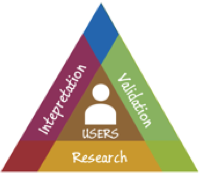User Centered Design (UCD) is a design philosophy and process that was coined by Donal A Norman in his 1986 book “the Design of Everyday Things”. The process consists of doing the research required to understand the needs of the user before the design process. This takes into consideration what the first-time experience of a user would be like through determinating the final learning curve of the product. User Centered Design research defines who your target audience is, and gives context to their work processes. Research like this is important because it gives insights into non tangible aspects such as user feelings, beliefs, and goals.
Contextual Inquiry
Contextual Inquiry are interviews with users that occur on discovery visits. We study the users process and by observing their tasks in their natural work environment we can determine key findings in order to base the software design. An important part of contextual inquiry is asking probing questions to gain insights about things that may not observed visually.
Interpretation Sessions
After gathering user data it has to become usable to people who weren’t at the interview. During an interpretation session customer information is shared with a team through conversations about what transpired at the visit. The team has the opportunity to ask questions and puts together artifacts based on the shared information, this can be work models, whiteboard sessions or design ideas. The goal is to create a shared understanding of the customer.
User Validation
User validation is taking designs out to users and testing their feasibility. It is best to test early and often. This can occur before production with lo fidelity wireframes, or clickable prototypes. If a product is already in use, it can add value to do a base line user test to get information that can be used to measure improvement after the redesign.
